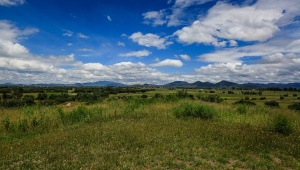Mexico’s plans for 6-runway airport revive resistance from neighbouring farmers
Mexico’s President recently unveiled details for a new Mexico City airport that will quadruple existing capacity, from about 30 million to 120 million annual passengers, and potentially become Latin America’s biggest transit airport. But a group of farmers living near the planned site is fiercely opposed to the project – and they have already taken down one airport project before. There have been plans for this huge airport – with 6 runways – for some 15 years. There are the usual claims, that we are so used to in the UK, of huge economic benefits, thousands of jobs, and a fear that not building it will cost vast sums of money ….. familiar? In 2001 farmers around the nearby town of Atenco protested fiercely, as they were threatened with land expropriation for very small financial sums. They had armed with machetes and Molotov cocktails, blocked roads and clashed with police, and eventually the project was cancelled.The President says this time the airport will only be built on federal owned land, with no expropriations. However, there are doubts about the legality of land sales, when people thought the land would be used for an environmental project, not an airport. Intense opposition remains, and farmers say they “will defend our land with our lives.”
.
Tweet
Mexico’s Plans For A $9.2 Billion Airport Revive Resistance From Neighboring Farmers
By Brianna Lee (International Business Times)
@briannaclee
b.lee@ibtimes.com
6.9.2014

Journalists and guests stand next to a mock-up of the new international airport after a ceremony in Mexico City, Wednesday, Sept. 3, 2014. Reuters/Tomas Bravo
Mexico’s President Enrique Peña Nieto unveiled this week details for a new Mexico City airport that will quadruple existing capacity and potentially become Latin America’s biggest transit hub. But a group of farmers living near the planned site is fiercely opposed to the project – and they have already taken down one airport project before.
The government has dreamed of overhauling the existing Benito Juarez International Airport for at least 15 years to ease oversaturation of the country’s second-busiest airport. Analysts say the existing infrastructure can handle up to 32 million passengers per year; last year, it saw 31.5 million passengers, and traffic is expected to keep growing.
The economic stakes are high: The Mexican Institute for Competitiveness, a Mexico City-based think tank, projects a new airport could contribute 1.4 percent to 2.5 percent of GDP, excluding the impact of tourism. That kind of a boost would surely be a boon to Peña Nieto’s legacy as he faces waning approval for his economic policies. Meanwhile, the think tank argues that not building the airport could reduce GDP by as much as 3 percent.
The new airport, according to the government’s plans laid out Wednesday, would cost $9.2 billion, cover 11,400 acres, include six runways and have the capacity to handle 120 million passengers. The first phase of the project, which includes the completion of three runways, would be finished by 2018. British architect Norman Foster and Fernando Romero, the son-in-law of Mexican billionaire Carlos Slim, were tapped as the project’s designers.
Peña Nieto has been careful to avoid the mistakes of former President Vicente Fox, who proposed a new Mexico City airport in 2001. Fox was forced to scrap those plans after farmers from the nearby town of San Salvador Atenco – 20 miles outside Mexico City – launched a fierce campaign against the government’s plan to expropriate their land for a scant 70 cents per square meter. Armed with machetes and Molotov cocktails, the protesters blocked roads and clashed with police, and eventually Fox canceled the project.
This time, Peña Nieto says the airport will be built entirely on federally owned land adjacent to the site of the 2001 proposed airport, emphasizing that no expropriations would be necessary. But members of the People’s Front in Defense of Land – the same group that led the 2001 demonstrations – jumped back into protest mode just hours after the president’s announcement.
“We continue to battle and are ready to fight,” said Ignacio del Valle Medina, leader of the front, at a press conference Wednesday. “We will not give up, and we send a message to Vicente Fox and Enrique Peña Nieto that is the same, that we will defend our land with our lives.”
Del Valle Medina said that the July 1 assembly of core communal landowners, which approved the government’s use of the land, was not held transparently or fairly, making the sale illegal. He also said that the airport’s proximity to Atenco would disrupt the residents’ way of life.
For now, it’s not yet clear if the front will be able to mobilize residents to the same degree as the 2001 protests, but it has called for its first widespread demonstration on Monday.
Atenco Farmers Demand Judges Grant Injunction Against New Airport
Editorial Board, Proceso,(dorset chiapas solidarity)
8th September, 2014
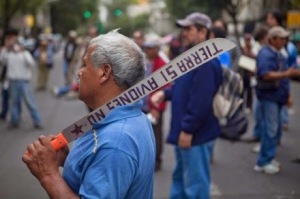 Mexico City – Campesinos from Atenco began demonstrating today in rejection of construction of the new Mexico City International Airport (AICM) in the Texcoco region. The project was announced by President Enrique Peña Nieto as a trigger for substantial social investments.
Mexico City – Campesinos from Atenco began demonstrating today in rejection of construction of the new Mexico City International Airport (AICM) in the Texcoco region. The project was announced by President Enrique Peña Nieto as a trigger for substantial social investments.
The Atenquenses. headed by Ignacio del Valle, leader of the Peoples’ Front in Defence of the Land (FPDT), arrived this afternoon at the Superior Agrarian Court (TSA) of the Federal District [Mexico City] to ask the judges to award the petition for amparo [protection, similar to injunction] filed by ejidatarios against the change of ejido structure to full [not collective] ownership.
The people’s distress, he pointed out, is because ejido lands were acquired arguing that they would be used for environmental projects and denying that they would be part of the new airport project.Ignacio del Valle and a group of representatives from eight communities in San Salvador Atenco were received by the judges. At press time, no additional information was available.
At an early hour, the group of campesinos gathered in the main square of San Salvador Atenco, where four buses were waiting to take them in convoy to the Federal District. Another committee left for the Unitary Agrarian Tribunal in Texcoco.
At exactly 9:20 AM, some villagers set out marching toward the Angel of Independence [in Mexico City] and then on to the TSA, in order to confirm their position to defend their land and oppose construction of the airport announced by Peña Nieto.
For Ignacio del Valle, who led the rebellion of San Salvador Atenco between 2001 and 2006, the new airport project will affect residents and ejidatarios in the area, because he said it is about a “future city” rather than a “green project,” as the government argued when it acquired the lands, and he emphasized: “They are projecting the airport in the same place (as in 2001); of course, it affects us.”
In an interview with Milenio [newspaper], Del Valle stated:
“Our resistance is not for greater payment; we are not saying that it wasn’t adequate. We do not want the airport project. In Atenco and other communities they have implemented the same system, the same deception. “(They said), ‘It isn’t the airport. These lands are to be used for another project, having to do with an ecological project. There won’t be projects like the future city. It’s certain: you are going to remain ejidatarios‘.”
FPDT’s leader explained that lands were purchased in two ejidos, one in Ixtapa, where the government bought the land “starting in 2001-2002 through CONAGUA (National Water Commision).” The rest, he added, were acquired when he and other Atenco leaders were prisoners, “on the pretext that they wanted the lands for an ecological project. We’re talking about 2008 and 2009, during the time we were imprisoned. They took advantage of that situation.”
Del Valle admitted that during construction of the first phase of the terminal the intent is to use federal and not ejido lands, but he fears that the reality might be something else. In the interview, he stated: “They are initially managing two runways. One apparent location has to do with land located on federal land, but I think that the reality has been hidden.
“We have to warn that the effect of dispossession is the same, because at this early stage they are not talking about the future city. They limit themselves to saying that it is the airport, and they say ‘we do not need another centimetre’, but that’s not true.”
Ignacio del Valle also accused the government of having “scared the ejido nuclei, the ejido representatives,” and of having purchased the land “in a concealed and fraudulent way.”
Translated by Jane Brundage
http://dorsetchiapassolidarity.wordpress.com/2014/09/11/more-about-the-new-airport/
.
.
Also
New Airport Will Bring More Urban Sprawl and Water Scarcity: Expert
César Arellano
La Jornada,
September 8th, 2014
Construction of the airport east of Mexico City, as announced by the federal government, will exacerbate problems of urban sprawl, over-development and water supply affecting the Valley of Mexico,* said Manuel Frías, civil engineer and graduate from the National Polytechnic Institute (IPN), who has been a consultant and adviser for public works and basic infrastructure projects in past federal administrations.
“The project does not take into account the environmental–both ecological and urban–impact that it will have on the region of ancient Lake Texcoco, where every winter thousands of migratory birds arrive, including endangered species.”
Frías also said that not only are the physical hydro-geology and groundwater characteristics ignored [in the proposal] but, at the same time, [the proposal] compromises the future destiny of the entire Valley of Mexico.
“The only thing that an airport in that area will promote, in addition to real estate speculation, is that the time frame for the collapse of the Valley of Mexico is shortened, because fostering uncontrollable territorial expansion and urban sprawl throughout its 2,000 square kilometres and will create difficulties regarding the availability of groundwater.
“Today 50,000 litres of water are extracted per second from the impaired [existing] aquifer; [the airport construction is] a disturbance that will give rise to foreseeable conflicts due to the reduction and scarcity of water.”
Frías added that “it isn’t just a question of architectural models, presentations and exhibits in order to support the technical and economic feasibility of a necessary and forward-looking airport, but of vision, imagination, responsibility and comprehensive knowledge of the conditions, characteristics, regional variations and hydro-geological transformations.”
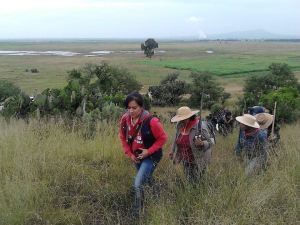 For Óscar Terrazas, a specialist in urban studies at the Autonomous Metropolitan University at Atzcapotzalco, the basin of former Lake Texcoco offers a number of advantages, “but the issue of land tenure and environmental impact studies in the area must take place in a responsible manner.
For Óscar Terrazas, a specialist in urban studies at the Autonomous Metropolitan University at Atzcapotzalco, the basin of former Lake Texcoco offers a number of advantages, “but the issue of land tenure and environmental impact studies in the area must take place in a responsible manner.
“It’s an asset to any city, above all, for great metropolitan cities like Mexico City, that they can count on a space to accommodate a large infrastructure.”
“The location’s proximity to Mexico City and to the existing airport seems to me to be convenient. It has advantages in terms of accessibility, services already available in the area, such that constructing an airport there is going to be less arduous than extending it to Tizayuca [state of Hidalgo; Tizayuca is 43 kilometers [27 miles], or 53 minutes by car from Mexico City].”
Translated by Jane Brundage
http://www.jornada.unam.mx/2014/09/08/index.php?section=politica&article=010n3pol
*An old problem, still unresolved, is the gradual settling of the old lake bed on which the city is built and the steady sinking of many buildings.
*********
New Mexico City Airport Proposal Developed Under Government Secrecy
5.9.2014
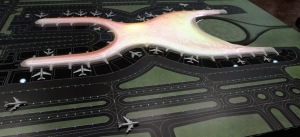 The initiative was introduced on September 3 by President Enrique Peña Nieto, who assured that the work will be done with transparency. The federal government launched the web page aeropuerto.gob.mx to provide information about the project. Although the web page has a section on transparency, there are no documents about the selection process.Aristegui Noticias
The initiative was introduced on September 3 by President Enrique Peña Nieto, who assured that the work will be done with transparency. The federal government launched the web page aeropuerto.gob.mx to provide information about the project. Although the web page has a section on transparency, there are no documents about the selection process.Aristegui Noticias
The project to construct the new airport in Mexico City is marked by a lack of information about the process by which the design proposal submitted by architects Norman Foster and Fernando Romero was chosen. Fernando Romero is a son-in-law of Carlos Slim, considered the world’s richest man, owner of Telmex and numerous contractors specializing in public works.
Gerardo Ruiz Esparza, Secretary of Communications and Transport, stated that selection of the design by Romero and Foster was the result of an analysis by a committee of experts, without either giving details of the process or specifying who was involved.
The decision, said the Secretary, took place last September 2, exactly two hours before President Peña Nieto delivered the message for his second year in office: “It is the product of a complete analysis conducted by a committee of experts, with specialists in this highly technical issue, at a high technical level, in order that the committee would act in favour of the proposal that met all the requirements. Yesterday at 9:50 AM, the committee voted unanimously in favour of the design submitted by architects Norman Foster and Fernando Romero.”
In an interview with CNN’s Carmen Aristegui, Manuel Ángel Núñez Soto, director of the Airport Group of Mexico City, said that the process was done under confidentiality, in order that it might be viable: “What in this case allows undertaking a market investigation by invitation and under the law of reserve to keep a project confidential.”
However, Núñez did not specify the criteria used to choose the design submitted by Foster and Rosemary, before adding: “Whoever won, won for a reason of principle … a committee was formed. We provided instruction that it was a very important project for the country. Here friendships, relationships, or situations of any nature other than the project that was in Mexico’s interest did not matter.”
Other participating firms were Gómez Pimienta Magar, Legorreta, Hernández Rogers, López Guerra, Javier Sordo Madaleno and Bringas, among others.
On its website, Norman Foster announced that it had won the “international competition,” without elaborating. Fernando Romero also noted that the proposal was selected after a nearly six-month long competition, without delving into the competition, the process or the decision.
Secretary Ruiz Esparza expressed gratitude for the participation of Mitre, an aeronautical research agency; of the organization of international civil aviation; the International Air Transport Association; as well as specialists, government agencies, the UNAM [National Autonomous University of Mexico] and the National Polytechnic Institute, but did not specify their level of responsibility.
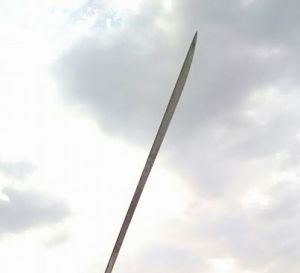 The only information available about the selection process is a direct award made in October 2013 of 3 million pesos [$229,420 USD] to the company ADHOC Consultores Asociados. This contract, signed by the Secretariat of Communications and Transportation, was for “an external consulting expertise to support selectively and strategically new projects for the realization of the airport in the centre of the country.”
The only information available about the selection process is a direct award made in October 2013 of 3 million pesos [$229,420 USD] to the company ADHOC Consultores Asociados. This contract, signed by the Secretariat of Communications and Transportation, was for “an external consulting expertise to support selectively and strategically new projects for the realization of the airport in the centre of the country.”
The names of the experts are not made public. Nor if they were responsible for selecting the winning proposal.
The lack of information is also reflected among those involved. In his speech, Secretary Ruiz Esparza said that the airport will need 4,600 hectares however, on his website, architect Fernando Romero reported that it will occupy 4,700 hectares while Norman Foster’s website indicates 5,555 hectares.
Furthermore, President Enrique Peña Nieto said that the first phase of the airport includes three runways, while Secretary Ruiz Esparza maintains that there will be two.
Translated by Jane Brundage
http://aristeguinoticias.com/0509/mexico/el-nuevo-aeropuerto-nace-entre-el-secretismo-del-gobierno/
.
from
http://dorsetchiapassolidarity.wordpress.com/2014/09/11/more-about-the-new-airport/
.
.
.
.


